
Quaker parrots are birds that have fun, energetic personalities. They are popular pets around the world. These talking parrots are quirky, intelligent, and entertaining. These colorful parrots are notorious in some parts of the world due to their effects on native wildlife and agriculture. In a striking balance between fame and infamy, quaker parrots are certainly intriguing animals. Learn all about these intelligent birds with these quaker parrot facts.
- Quaker parrots are medium-sized birds that grow to about 11 to 13 inches in length from head to tail.
- These parrots have an average body mass of about 81.7 g (2.88 oz).
- They incubate their eggs for about 24 days.
- The French polymath Georges-Louis Leclerc, Comte de Buffon first described the species in his 1780 work Histoire Naturelle des Oiseaux.
- Quaker parrots have a lifespan of 20 to 30 years.
- Quaker parrots are also called monk parakeets or hooded parrots.
- They are considered as true parrots.
- Quaker parrots are active during the day.
- They are native to neotropical regions.
- They can get territorial and aggressive towards anything they feel might be intruding and threatening their homes.
- Quaker parrots typically breed in late August up to November.
- The scientific name of the quaker parrot is Myiopsitta monachus.
- Monachus in their species name is the Late Latin term for “monk”.
- Quaker parrots belong to the parrot family Psittacidae, the same family as blue-and-gold macaws and grey parrots.
- There are three known subspecies of quaker parrots: M. m. monachus, M. m. calita, and M. m. cotorra.
- Some of the nests built by quaker parrots can reach the size of a small car.
- Baby quaker parrots sometimes “quake” or shake their heads when begging for food.
- Quaker parrots get their name from their gray face and underparts, which resemble the bibs of Quakers.
- The coloration of their feathers also give them a “hooded” appearance, which is why many refer to them as monk parakeets.
- Their colonies have “dialects” or vocalizing sounds unique to their groups.
Quaker Parrot Facts Infographics
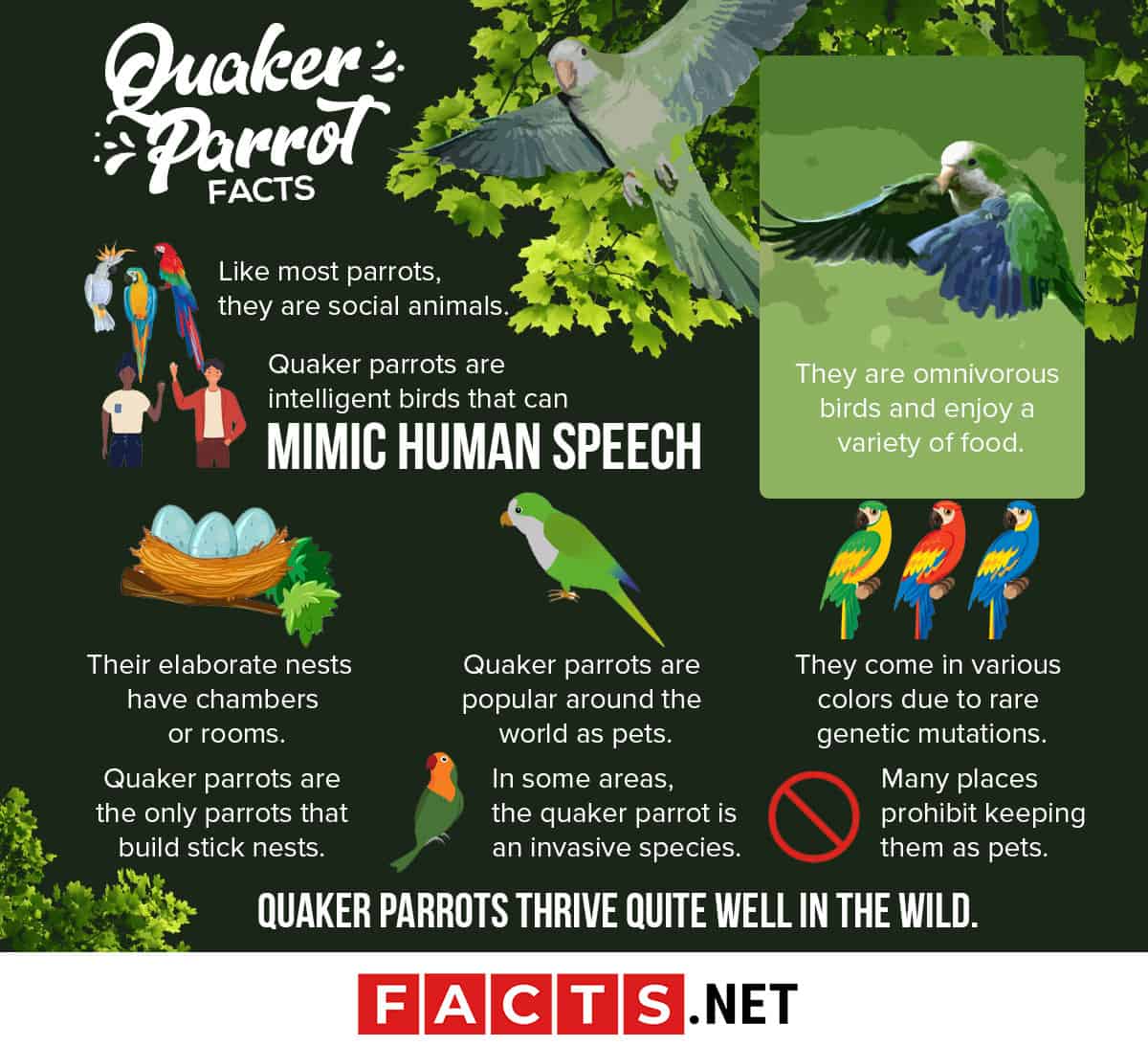
Quaker parrots are intelligent birds that can mimic human speech.
Like crows, parrots are well known for possessing intelligence that far surpasses most other birds. The quaker parrot or monk parakeet is no exception. This parrot demonstrates excellent memory and can even plan for future events, which requires a higher level of intelligence. As birds with a high level of intelligence, they tend to get bored and require mental stimulation and entertainment through toys and social interaction. If they get bored, they can have destructive tendencies, which may not be ideal if you’re keeping them as pets. These intelligent birds may even enjoy music.
Quaker parrots can also memorize various sounds and voices with ease. As with many other parrots, quaker parrots are exceptional mimics. They can learn a large variety of words and phrases. Like larger parrots, they can speak quite clearly and even give meaning to words. They are capable of contextual speech, or saying things in context. For example, they can bid you goodnight before it goes to bed and say hello to guests. Not every quaker parrot can talk, however — but if they can, they do so with excellence.
As with other parrots, monk parakeets have a large and complex forebrain, which is tied with their reasoning and higher-order thinking skills. Quaker parrots can solve puzzles and learn tricks with relative ease. This is certainly one of the quaker parrot facts that make them well-loved as pets.
They are omnivorous birds and enjoy a variety of food.
Quaker parrots are omnivores and can eat a wide variety of food, including fruits, flowers, leaves, grasses, seeds, and insects. In captivity, they enjoy eating an assortment of seeds and pellets specifically tailored to mimic their diet in the wild. They can also eat cereal crops, drying meat, nuts, and sweet potatoes.
Like most parrots, they are social animals.
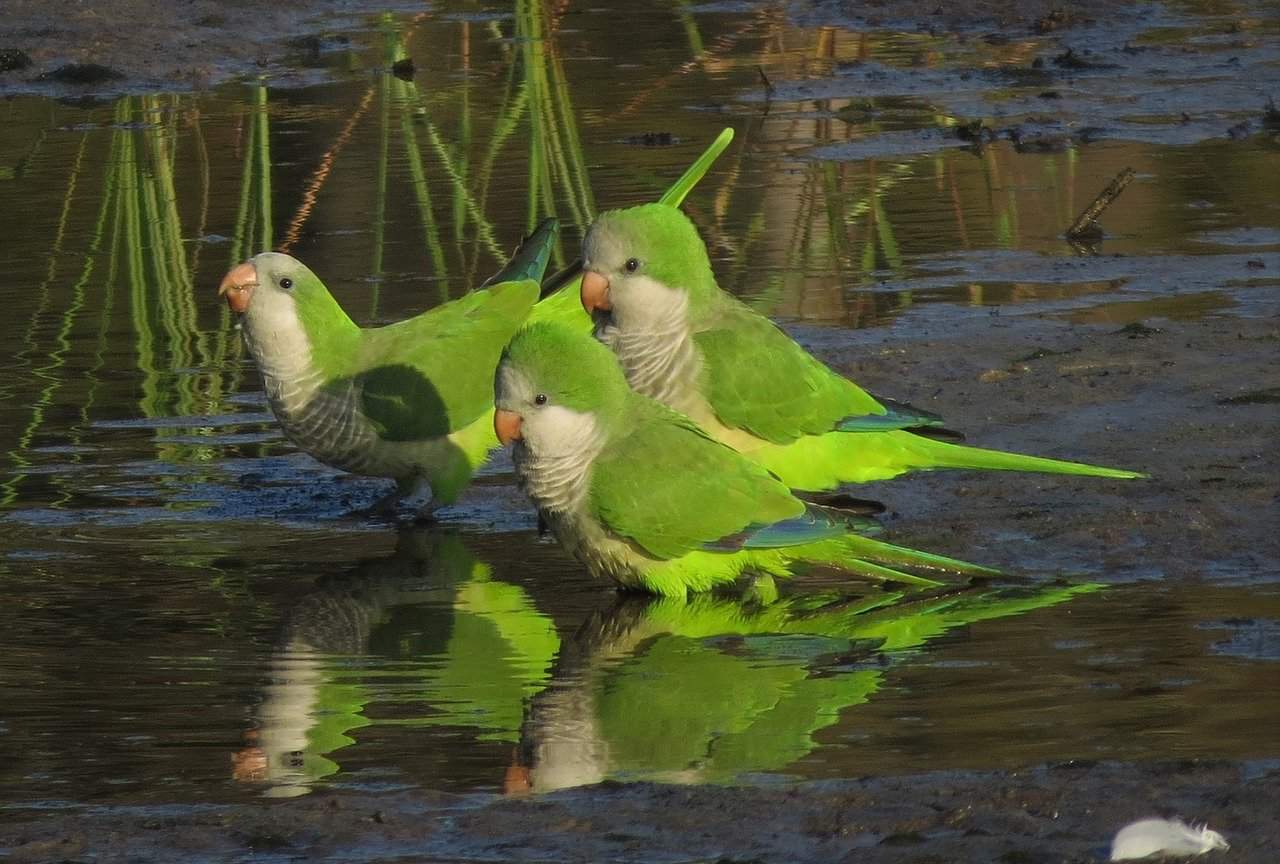
Quaker parrots are social animals and tend to live in large flocks in the wild. They are gregarious birds and prefer to live together in the same nest — a single nest can house multiple pairs of quaker parrots at once. Quaker parrots often live in large flocks in the wild. They communicate through visual, tactile, chemical, and auditory cues. They don’t shy away from humans in the wild. When they’re kept in captivity, they also appreciate the company of humans.
One of the most interesting quaker parrot facts is that they also help other quaker parrots raise the young. Oftentimes, quaker parrots help their parents in feeding their younger siblings.
Quaker parrots are the only parrots that build stick nests.
Parrots typically nest in holes in trees, rocks, the ground, abandoned dens of other animals, or man-made structures. The quaker parrot, however, is the only exception. They are the only parrots that build nests using sticks and twigs, and these nests can get quite large because they can house many individuals.
Quaker parrots sleep and lay eggs in their elaborate nests. They lay 4 to 12 eggs in a single clutch. While they tend to feed close to their nests and rarely venture far from the nests, flocks in South America may migrate in the winter to look for areas with an abundance of food. If the flocks live near urban or suburban areas, however, they can find food year-round and no longer need to migrate in the winter.
It’s not uncommon for these parrots to build nests near human settlements. Their large nests sometimes attract other animals to live there, including small mammals, ducks, and birds of prey.
Their elaborate nests have chambers or rooms.
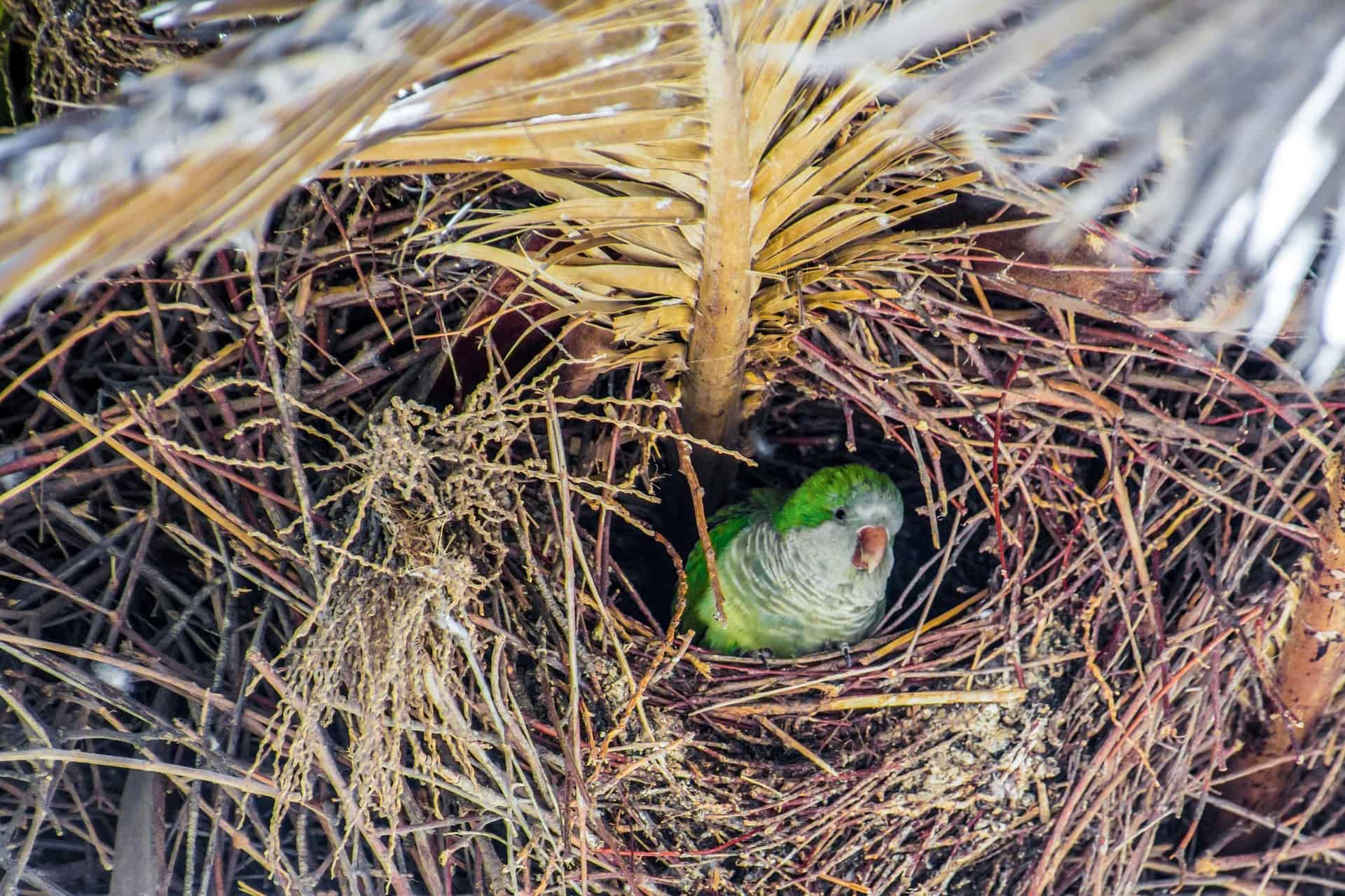
This is undoubtedly one of the most intriguing quaker parrot facts that you just can’t miss out on. The striking intelligence and sociability of quaker parrots can be seen in the unique architecture of their nests. Each pair of quaker parrots build at least two chambers or rooms in the nest, and they expand the nest by building more chambers as the flock grows in number, which resemble human apartments.
Each room serves a different function. Typically, quaker parrots incubate their eggs in one chamber, while the other may be reserved for older chicks or for parents to look out for potential threats.
Quaker parrots are popular around the world as pets.
One of the more well-known quaker parrot facts is that they are popular in the pet trade. Due to their bright colors and equally bright minds, many people value quaker parrots as house pets. As social animals, they can be quite docile and trusting of their caretakers. Furthermore, there is always an appeal in keeping an animal that can talk like a person. These talking birds can be as popular as cockatiels, and they are quite hardy pets.
Another appealing factor in their popularity as pets is their smaller size, and consequently, their fewer requirements when it comes to food and habitat space. Compared to larger parrots with similar intelligence and talking ability, such as the African grey parrot or the blue-and-yellow macaw, quaker parrots are generally cheaper and typically require a smaller space. However, it’s generally still advisable to house these birds in large enclosures to give them room to fly and roam around, keeping their curious minds entertained.
They come in various colors due to rare genetic mutations.
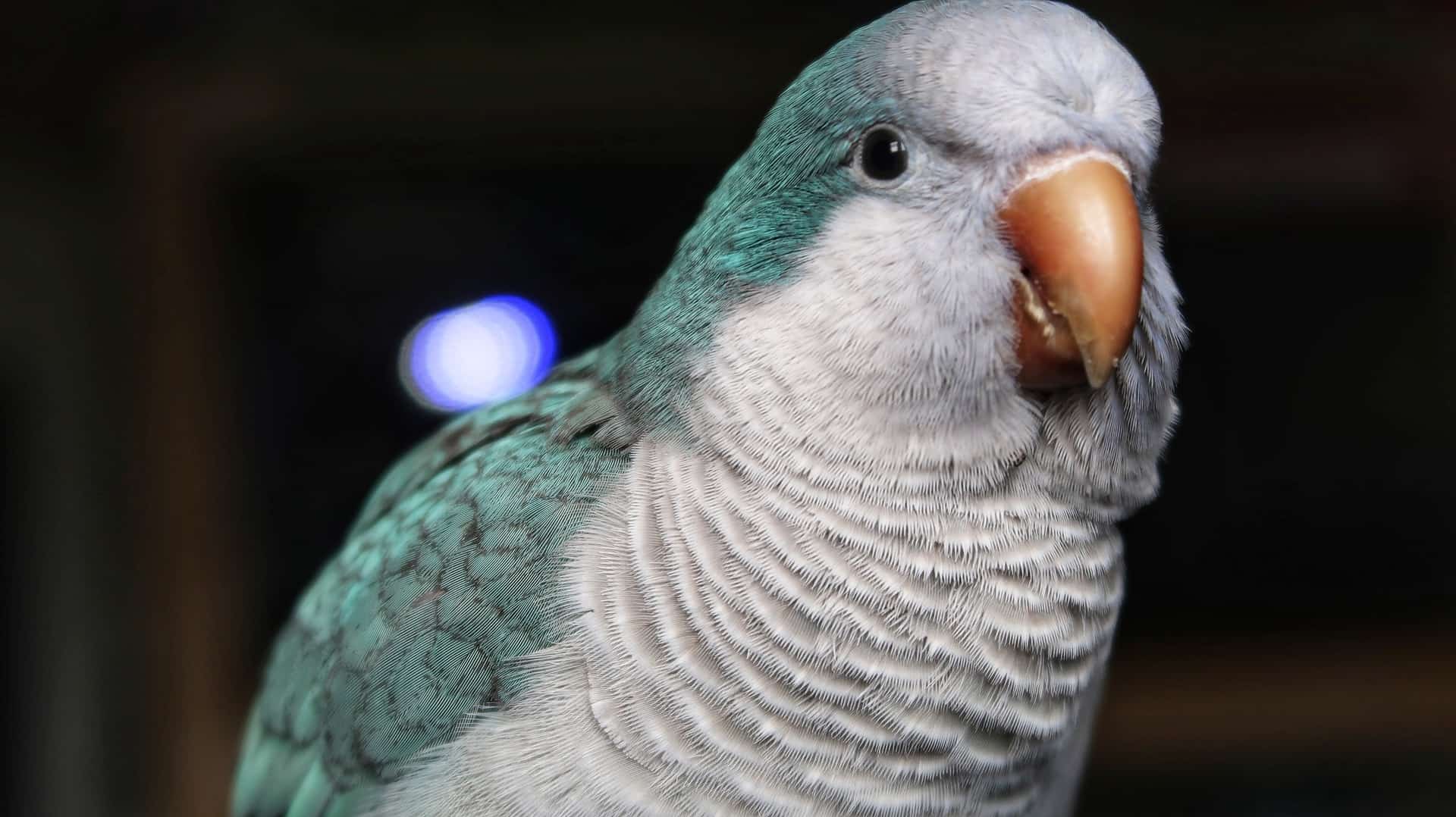
The wild forms of the nominate subspecies of quaker parrots is naturally green and gray in coloration. They have pale gray cheeks, lores, and throats, as well as blue-gray foreheads. On their throats and abdomens, the feathers have edges that are lighter in color, which makes the feathers appear scalloped or barred. Their upper parts, on the other hand, have bright green feathers.
They have brown eyes, gray legs, and pinkish-brown beaks. Male and female quaker parrots do not differ much in appearance, apart from the females typically being around 10–20% smaller than males.
Due to rare genetic mutations, however, some domestic quaker parrots exhibit atypical feather colorations, which are highly sought after by breeders. Quaker parrot breeders have been able to produce parrots that have white, blue, yellow, and cinnamon colored feathers. Because these mutations are rare, the breeders sell these parrots at a higher price than the normal green ones.
In the wild, their typical green coloration provides them with efficient camouflage in grasslands and forests. This coloration helps the quaker parrots survive and reproduce more in the wild and is therefore the most prevalent coloration in the species.
Quaker parrots thrive quite well in the wild.
The natural habitats of quaker parrots are palm groves, open savannas, and scrub forests — particularly places with little rainfall. Quaker parrots are native to Argentina and its neighboring countries in South America. They often live near large water sources such as rivers and seas, sometimes establishing nests near human settlements. However, these parrots are highly adaptable to new environments and can thrive in a wide range of habitats.
According to the International Union for Conservation of Nature (IUCN), these parrots are of least concern and currently are far from facing the threat of extinction. In large part because of human introduction to new habitats, quaker parrots have large populations and are common around the world. Escaped or released quaker parrots readily take on new habitats and establish feral colonies that can survive on their own.
Because they are parrots native to temperate zones, they can survive in colder climates. In the United States, they have established multiple colonies in the northern states such as New York, Massachusetts, and coastal Rhode Island. Even with harsh winters, they also have a healthy population in Chicago, Illinois, where the people generally welcome their presence.
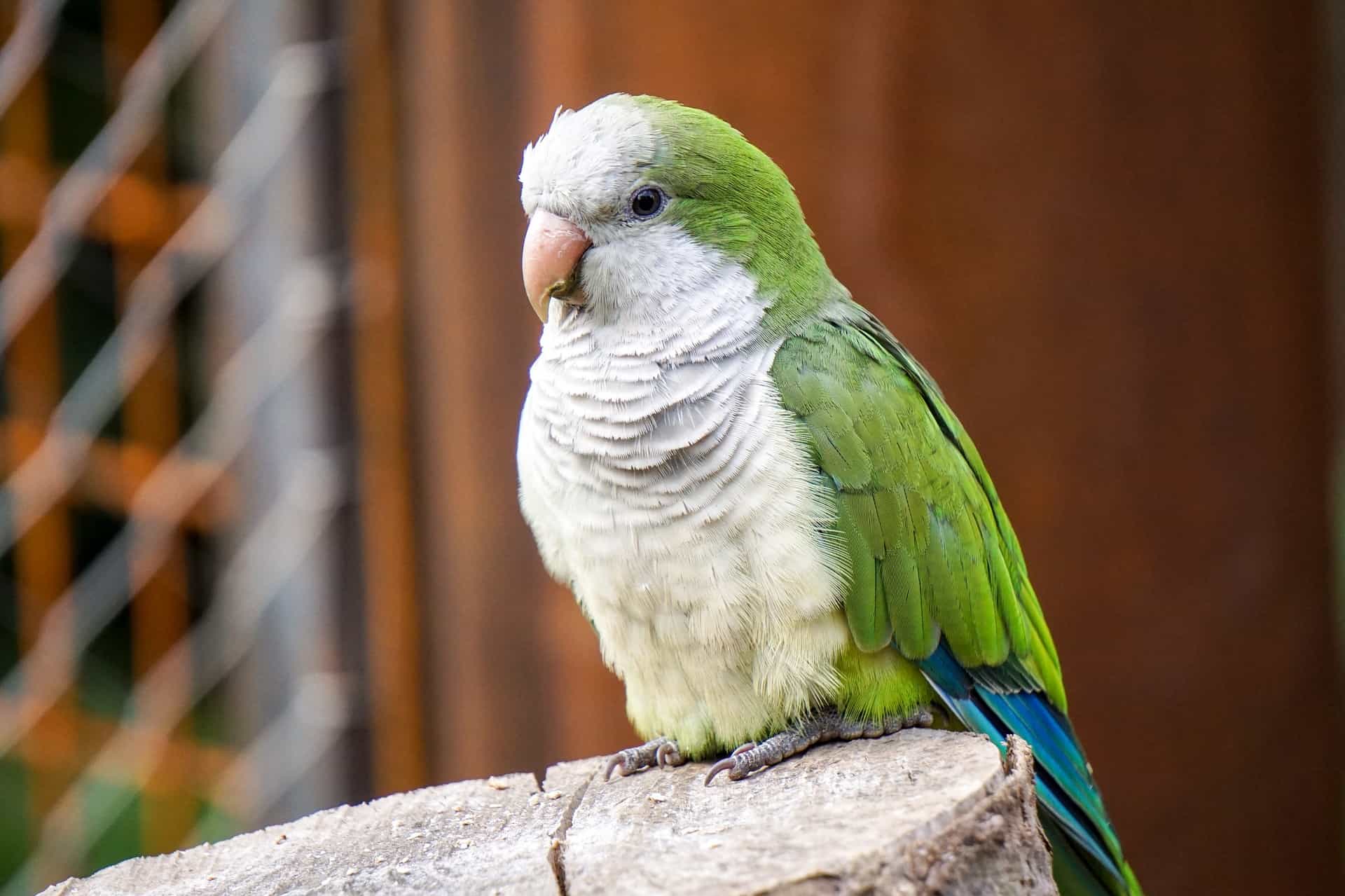
In some areas, the quaker parrot is an invasive species.
Because of their capacity to thrive in a wide range of habitats, they can be as common as pigeons in some areas around the world. In 2015 alone, the city of Madrid in Spain had a quaker parrot population of around 10,800 individuals — the highest population of quaker parrots in Europe. The United States also has its fair share of quaker parrot populations, because there are around 150,000 to 500,000 parrots in the state of Florida alone.
While these birds may be adorable and entertaining to look at, and even welcomed in some areas, one of the most crucial quaker parrot facts you should know is that they can be invasive species. These smart birds can prove to be quite a nuisance in places where their populations remain unchecked. With large enough populations, they can consume a significant amount of resources and compete with the local wildlife — such as pigeons and sparrows. They also can become agricultural pests, eating and decimating the valuable grain crops of local farmers.
Many places prohibit keeping them as pets.
It’s no surprise that because quaker parrots have a reputation for being invasive species in many places around the world, some countries and states have started banning people from keeping them as pets. Spain, for example, where the quaker parrots are nearly as common as pigeons, has made it illegal to keep, sell, and breed the birds since 2013. The United Kingdom’s Department for the Environment, Food and Rural Affairs also made a plan for population control in 2011. Western Australia also outlaws the possession and sale of these potentially-invasive quaker parrots.
Because of the pet industry, the United States imported thousands of quaker parrots from the 1960s to the 1980s. Because of escaped pets or owners releasing them in the wild, they quickly established colonies in seven states around the 1970s, and their populations subsequently spread to other states. In the United States, keeping pet quaker parrots is illegal in some states such as California, Rhode Island, Kentucky, Connecticut, Wyoming, Georgia, Hawaii, Colorado, and Pennsylvania. In some states, it’s legal to keep one as a pet but they have certain restrictions that must be met. For example, in Ohio, captive quaker parrots must have their feathers clipped to prevent them from flying away.
Was this page helpful?
Our commitment to delivering trustworthy and engaging content is at the heart of what we do. Each fact on our site is contributed by real users like you, bringing a wealth of diverse insights and information. To ensure the highest standards of accuracy and reliability, our dedicated editors meticulously review each submission. This process guarantees that the facts we share are not only fascinating but also credible. Trust in our commitment to quality and authenticity as you explore and learn with us.
